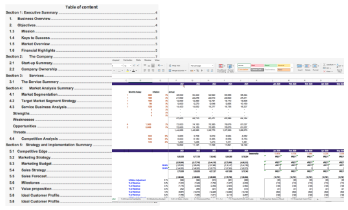Grow Your Landscaping Business: Solutions to 10 Biggest Challenges

Dealing with business challenges is tricky in the face of changing technology, consumer behavior, and regulations. It is not surprising that only 25% of businesses survive for 15 years or more according to the US Bureau of Labor Statistics (BLS).
If we bring the spotlight on what these businesses do differently to overcome the challenges, we could probably be able to decode the secret of staying afloat in the market for long. Starting off with the idea, we tried to catch up with the ways successful landscaping companies counter common challenges or say causes of growth stagnation, operation inefficiencies, and profit erosion.
Here is what our curiosity led to—top 10 landscaping business challenges and ways successful landscaping businesses overcome them.
1. Having a Plan
Many entrepreneurs fall into the fallacy of thinking that they have their whole business plan exquisitely written in their minds. The problem with those plans is they lack commitment and are subject to inferior information based on assumptions.
Even an HBR study reveals that entrepreneurs who write their formal business plans are 16% more likely to succeed than otherwise identical non-planning entrepreneurs.
According to experts, the planning process requires a futuristic approach—with both short-term and long-term goals. While short-term goals are majorly driven by data insights, long-term goals require visionary thinking of “how the industry will evolve and the position to dictate terms in the future.”

Image source: Harvard Business Review
At each level of this planning cone, you need to evaluate your landscaping business from different perspectives. And what could be the best way to begin the evaluation process than to ask the right questions?
As in at the tactical stage, you could ask different questions for different business processes. For instance, questions at the tactical stage for marketing could be:
How are you going to market your landscaping services? For say, you are going to present yourself as:
- Most reliable
- Most creative
- With high value
- Convenient
- Cheapest
- Or the best
If you have begun as the cheapest in the first few years, in the next 2-5 years, at the strategic level, you could market yourselves as the most convenient and most creative, depending on your goals. Similarly, when you are into financial planning at the tactical stage, the question you could possibly ask is:
How much are you going to generate from a specific neighborhood? Or which service is your highest source of profit and how can you maximize it?
While at the strategic level, you need to plan on scalability with the recurring revenue model. And for that you need to drill down deep into your services to figure out:
- Who is buying from you?
- Who do you want to buy from you?
- How can you make them buy your services?
- What would be the cost impact? And so on.
At the visionary level, you need to identify market forces that impact the industry such as technology and consumer behavior to modernize your landscaping services.
As you move forward in the cone, you will realize that success in your business is more about leadership and appropriate decision-making rather than objective elements which are simply the outcome of your decisions.
Plan Meticulously

Business plan & financial analysis
template with examples
2. Winning new customers
Most businesses interact with only the top 3% of the buyers in the entire marketplace, according to Dan Lok, a Canadian entrepreneur and social influencer.
These top 3% are readily available buyers who need landscaping services at the given time, but there is a large section of prospects who do not need the services at the moment but perhaps in the future.
He further categorizes the types of buyers as hierarchical levels within a pyramid in the YouTube video and explains the concerted efforts required to tap into the prospects at the lower levels of the pyramid.
The landscaping business is location-specific. And so technically, it is easier for companies to drive their customer acquisition strategies focused yet on a multidimensional level. Here is a 3-phased model of tapping into prospects at the different levels of the pyramid in order to increase conversion.

(i) Discovery
At the discovery stage, be the detective to find out the most effective customer acquisition channel so far in your business. For example, some landscaping service providers consider organic search as their best source of acquiring new customers whereas others have got the great results from referral programs.
In the long run, you cannot be dependent on just one source for acquiring new customers. You have to open up new channels while strengthening the existing ones.
Keith Kalfas, one of the most popular landscaping business owners and social influencers, discusses 7 steps to marketing your lawn care & landscaping in a video which is extremely helpful to take your marketing game to the next level. Here is the listing combined with our own expertise and other landscaping business leaders.
- Google My Business: List your business here to check customer inquiries right away and collect positive reviews from customers to build your brand.
- Social Media: You can start with creating pages on social sites, beginning with, Facebook, Instagram, and Pinterest, and then to LinkedIn, as your business grows.
- Email Marketing: Use email marketing tools such as MailChimp to send promotional emails to customers and then measure the results.
- Search Engine Optimization (SEO): Create your own landscaping business website and start promoting it on popular search engines.
- Referral Programs: Reach out to your customers and the local business community such as window cleaners, plumbers, and electricians to create a robust referral program.
(ii) Engagement
Setting up accounts and creating pages or websites are not enough. You need to effectively create an omnichannel brand experience on every platform. Not all your customers use a platform the same way. For example, some of your customers love using Facebook, while others check emails frequently.
Make yourself available on the platforms where over 80% of your ideal customers hang out on and deliver the same kind of experience. Create a platform-specific brand identity—talk about your USP, present case studies and customer testimonials to validate your brand, and be loud and clear about the value proposition you can add to their property.
Also create branding material that could attract buyers’ attention on the spot such as banners, pamphlets, and cards that have a good recall value.
(ii) Experience
As Dan Lok says, give your prospects a piece of your business service to experience. Nothing is comparable to the actual experience of a service when it comes to letting customers know the value you can add to their life or the problems you can solve with your landscaping services.
You can plan a trial of your landscaping services in such a manner that while the customers get to see in advance the value in your services, it is not too heavy on your pocket.
3. Cash Flow
Too often business owners make the mistake of gratifying themselves with a healthy profit on financial statements. However, having a healthy profit is not enough. According to the CB Insights report, negative cash flow is the reason for failure in 29% of startups.
Maintaining solid cash flow at all three levels—operating activities, investing activities, and financing activities are essential to keep the landscaping business financially healthy. It requires strong processes and proper visibility into the processes to keep your head above the water in the finance department.
For example, to strengthen your cash flow from operating activities, you need to speed up your invoice-to-payment workflow. Here are a few quick tips that could help you achieve that.
- Check the payment history of the customers
- Use a delivery acceptance letter to have proof that the customer has received specific services from you
- Issue clear invoices with specific terms and conditions to your customers
- Follow-up regularly by email (for checking and validation purposes)
- Incentivize direct cash payments and charge for late payments
You can use invoice and payment management software to speed up your payment process and simultaneously keep a time-stamped record of every payment activity that occurred in your business. The software can provide you with visibility into day-to-day expenses and thus enabling you to manage your cash flow more efficiently.
Also, landscaping is an asset-intensive business. That means you clearly have to invest in equipment to stock up your inventory levels. To ensure that such investments do not put you in between rock and a hard place ever due to the unavailability of cash, you can fix a cash reserve level specific to your business, and ensure the investments never rise above that level.
4. Hiring Quality People
Most of the landscaping contractors are independent individuals who work with 3-5 seasonal staff. Finding like-minded individuals who can work on shared objectives and with the same level of enthusiasm is a big challenge.
Besides, every day is a different day in the landscaping business. One day the team is working on routine activities and the other day, they are working on safety guidelines and equipment preventive maintenance work.
You need people who are multi-skilled, open to handling all the aspects of landscaping, and willing to work in a collaborative culture. Most landscapers are temporary workers and it gets difficult for companies to hire and retain them for a long.
An effective way to handle the problem is to create an ecosystem of the right people—build rapport with the other landscapers to share the workload and take an active role in the industry associations to connect with professionals and become a part of policy-making.
Connecting with universities that offer landscaping courses is also a great idea to attract talent who understand landscaping at the ground level meanwhile also willing to gain some experience in the industry.
5. Employee retention
While hiring the right candidate is largely dependent on on-the-spot judgments, employee retention is the outcome of long-term work culture and business requirements. The two major challenges with employee retention programs in landscaping businesses are:
(i) Whom to retain?
Landscaping is a seasonal business for many small and mid-sized organizations. The desperately needed snow scrapers in winter are not required in spring. So if retaining them for the whole year is a huge cost, losing them means repeating an excruciating cycle of hiring during peak season, which has cost impacts too.
Most companies rely on workforce management tools to check on the performance of their employees and keep a database of contractual staff, temp workers, and vendors, who could help them with additional staffing during the season.
These tools are helpful in identifying the skill of your workers and assessing their on-the-site performance using a metric system. The tools remove the biases and prejudices of the leadership team, enabling them to evaluate the performance totally on the basis of skills and efficiency.
(ii) How to retain?
Ways of retaining work differently for different members of the team in a given period of time.
At some point, your team needs rewards in the form of bonuses and incentives, while other times, they need recognition and appreciation for their work and sometimes beyond work.
For instance, DeSantis, owner of DeSantis Landscapes, headquartered in Portland, as published in Turf, an online landscaping magazine, sends flowers to employee’s family members in big life events such as birth or death. He even sends hand-written cards to his employees on their birthdays with lottery tickets.
You can create rewards and recognition that suits your business requirements and boost an employee-friendly work culture to retain employees who are a great fit to your landscaping business.
6. Training
Preparing landscapers for the upcoming season is a huge task. Actually, training is necessary for both entry-level and seasonal employees because of the rapid advancement in landscaping techniques and technology and changes in plant health problems due to the changing climate.
Although most entry-level professionals learn directly on the job, creating a training plan that could prepare them before the season arrives would be helpful in increasing their on-the-task productivity levels. You could set up a learning management system for either self or assisted training programs as well.
Similarly, you can evaluate the skills of seasoned professionals and provide them training to enhance their existing skills and also get a grasp on recent trends prevailing in the market.
Create a course plan based on the role and accountability and competency model that not only enhances the knowledge of the landscapers but also distinguishes your business from the other competitors and creates a brand value as an employer. You may find this post on how to build a high-performing field service team helpful.
Every landscaper in your team must have a clear idea of your business goals and the contribution in terms of the quality of the work expected from them.
7. Too many tasks, not enough time
Maintaining the landscape pristine throughout the year involves a multitude of tasks that must be performed properly at the right time.
From following a strict chronological order in land preparation to ensuring the economic and aesthetical benefits of the business, the list can go on and on. Most business owners we talked to often complained about the time constraints in the landscaping business.
A typical work order during best seasons includes around 10-14 tasks, such as condition, prepare, till, grade, fertilize, seed, mow, water, prune, and weed control. As the business is seasonal, you cannot risk delays, as it would mean losing the advantage of natural processes.
Scheduling and dispatching landscapers on time with the right equipment make a big difference to operations and profitability. Many managers feel the heat of paper-based processes as they are not able to properly track and monitor their employees activities.
Recently many companies have shifted to field service scheduling software that provides an on-the-fly view of employees, their real-time location, and complete visibility into the work order process.
Although tools are helpful but effective planning is the key and that requires skilled personnel on board who can manage entire service operations seamlessly.
8. Equipment maintenance
The two key problems in landscaping equipment maintenance are:
(i) Since the business is seasonal, keeping the equipment safe and in a ready-to-operate condition when the crew needs them at the job site is a challenge.
(ii) A variety of equipment is used in the landscaping business. It is a huge problem for the fleet manager to ensure proper usage and maintenance of equipment on a routine basis.
Having a proactive maintenance strategy is integral to improving the equipment’s uptime. Many landscaping companies use either a landscaping management software or CMMS or an equipment maintenance program to record, track, and monitor the equipment, and set a configurable preventive maintenance schedule to notify the crew member about the upcoming maintenance.
As the fleet manager gets visibility into the inventory and historical usage data, they can track the equipment in use in real-time and bring predictability to the maintenance and service plans of equipment based on those historical usage data.
9. Regulations and government guidelines
Planning the work following green industry regulations at state and municipality levels whether it is related to the use of pesticides and fertilizers or the equipment and pollution levels is a big pain for landscaping contractors.
Although regulations are there to protect public health and security and conserve property, their cost impact on the business is mostly high. For example, many landscaping contractors complain that they have had to buy new vehicles or use equipment only for a certain timeframe to adhere to the pollution levels.
There are similar guidelines related to planting, yard waste disposal, fertilizers, and pesticide ordinances and taxes, which are often unnecessarily costly. What landscapers can do is get more involved in their state-level associations to stay on top of the regulations. It could help them to engage in substantial lobbying activities to influence the decisions on pressing issues.
On operations levels, companies can rely more on technology to keep their employees abreast of the latest regulations and guidelines. Having the right inspection tools, historical records, and a knowledge-base integrated with the internal systems like field service platform that are accessible by the employees anytime, anywhere could help in keeping up with the regulatory standards.
Landscaping contractors can conduct post-work inspections that ask the workers to perform checklist-based inspections to ensure they have followed the guidelines and validated with the right proofs like images and videos help in compliance.

CHECKLIST ForLandscape Maintenance
& Compliance
10. Competing against unprofessional
Although the landscaping industry is growing and getting more organized with time, there is no dearth of fly-by-night landscapers. They are the non-licensed, uninsured businesses that drive down the pricing with their inferior quality works.
Such contractors are more interested in making quick money for a few seasons. And since they mostly deal in cash to avoid taxes, their services are kind of cheaper.
Another problem that affects industry professionals is how consumers view landscaping services. Most times consumers treat landscapers simply as gardeners or hobbyists. Landscaping is not just about decking an area instead creating an experience that is going to last for years.
Consumers must be educated from both aspects—the benefits of dealing with professional landscaping business on a larger community level and the importance of landscaping for the value of property perspective.
The Way Forward
As it is said in the business, “It’s easy to start, challenging to maintain, and very difficult to sustain and grow in the long term.” Starting a business is comparatively easier than sustaining the business, which requires you to work on operational and financial aspects with meticulous planning and adopt a forward-thinking approach.
Want to learn how you can use FieldCircle to improve operations effectiveness and profitability, and drive growth?


